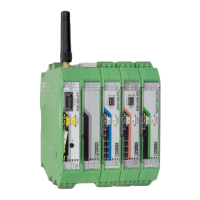For your safety
3827_en_B PHOENIX CONTACT 7/138
The radio should not be operated without an antenna or terminating load on the antenna
connector.
1.5 Safety regulations for installation in potentially ex-
plosive areas
Installation in areas with a danger of dust explosions
Installation in Class I, Div. 2 or Zone 2
NOTE:
The IP20 degree of protection (IEC 60529/EN 60529) of the RAD-900-IFS is intended for
a clean and dry environment. Do not subject the device to mechanical and/or thermal
loads that exceed the specified limits.
The RAD-900-DAIO6 provides an IP65 degree of protection.
NOTE:
Prolonged operation without an antenna or terminator may result in damage to the radio.
WARNING:
The device has not been designed for use in potentially dust-explosive atmospheres.
WARNING:
The device is designed for installation in Class I, Division 2/Zone 2 (UL/cUL) potentially
explosive areas. Observe the specified conditions for use in potentially explosive areas.
Install the RAD-900-IFS into a housing (control or distributor box) with at least IP54
protection (EN 60529) and is certified for use in Class I, Div. 2 or Zone 2.
The RAD-900-DAIO6 meets the IP65 degree of protection does not require an additional
housing.
When installing and connecting the supply and signal circuits observe the requirements of
EN 60079-14. Only devices suitable for operation in Ex zone 2 and the conditions at the
application site may be connected to the circuits in zone 2.
In potentially explosive areas, only connect and disconnect cables when the power is
disconnected.
Installation/removal of the devices on/from the TBUS DIN rail connector may only be
performed when no voltage is applied.

